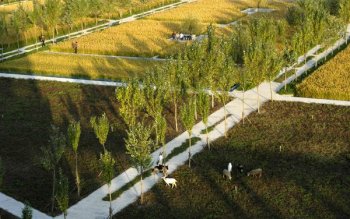
 2. Landscape Assessor
2. Landscape Assessor
Landscape assessors estimate the positive and negative qualities of new landscaping projects. They study the existing environmental components, such as relief, infrastructure, waters, flora, as well as the possible long-term effect of the project on them. Thus, they explore whether certain projects should be accomplished or not.
3. Environmental Designer
Environmental design involves multidisciplinary experts in the fields of urban planning, landscape architecture, and architecture. Environmental designers emphasize environmentally conscious techniques and materials in order to find the balance between functional and ecological demands when designing new constructions.

4. Residential Landscape Architect
Residential landscape architecture is based on the respect for the environment and the need to create outdoor living spaces that highly improve clients’ lifestyles. Residential landscape architects design natural land areas in and around neighborhoods, houses, and other residential areas. They are concerned with some specific aspects of each project, such as the client, the site, the home, etc.
5. Nursery Grower
Nursery growers cultivate trees, shrubs, and flowers for sale or use in parks and landscapes. They tend to plants throughout their growth by transplanting, pruning, watering, and fertilizing them, and can also interbreed plants. Some nursery growers own their small business, while others work for large nurseries that supply plants to garden centers or large landscaping companies.
Related Articles:
6. Academic Career
Theory and practice: Which one fits you best? If you are interested in research, administrative responsibilities, or teaching, an academic career path may be your perfect decision. As an academic, you will be expected to come up with ideas for original research, to gather information from relevant sources, to publish reports, etc.
Source: landarchs.com
Landscaping Tips
Though your home is your castle, there is no necessity to surround it with a moat. Here are 5 tips that will help you to make your landscaping feel more warm, welcoming and cozy.
1. Put some flowers nearby your entrance. Flowers make any area look more welcoming and attractive, so greeting your guests with Petunia, Snapdragon, Lily-of-the-Nile or some other garden flowers is always a great thing to do. What is more, to add some space between your house and the entrance, you can consider adding a little white fence. It will create an illusion that your front yard is bigger than it actually is. What is more, adding fence will create a great space for planting flowers to add some color and coziness.
2. Add rambling vines to make your yard look absolutely lovely. You can not deny that rambling vines always create romantic and even magical atmosphere. So why not to use this tip while decorating your yard?
3. To hide the unattractive driveway, consider adding some color, texture, and height. You can easily do it by adding various sorts of flowers. To start, create an island of green lawn right in the hub of a drive. Then add a couple of low boxwood hedges with flowers toward the back of your island.
4. If you want your yard to blossom and flourish bust still do not have enough time to maintain it, consider planting low-fuss lilies. Such flowers look absolutely gorgeous and come in the variety of rainbow hues, so you can pick the one you love most. What is more, low-fuss lilies do not care about the sort of soil, they love the sun and welcome hot, they do not afraid of drought. In other words, Crinums is an ideal flower for all those who are looking for low-maintenance solutions.
5. The last tip also touches the low-maintenance aspect. To make your life easier, group plantings into beds and islands. This will help you to avoid mowing and trimming around each individual plant, save a lot of time and even money.

 2. Landscape Assessor
2. Landscape Assessor



















